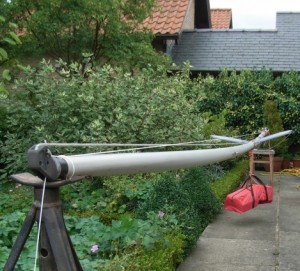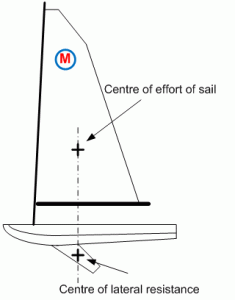One of the many attractive features of the Moth is freedom in the choice of spars; the downside can be too much choice.
The aim here is to address some of the basic issues.
Mast stiffness
Perhaps the first consideration if you are buying a new boat or replacing a mast is mast stiffness. Having a mast that is too stiff makes flattening the sail off in a blow harder, but is more powerful in medium airs. Too soft and you will not be able to power the sail up, especially reaching.
I guess here the deciding factors are your weight and what kind of sailor you are: heavy, aggressive helms can run with a stiffer mast than the lightweight, or that for whom hiking out is sitting on the side tank. Commercially available masts would range from say the SuperSpar M7 for heavy/aggressive sailors to the Selden Lambda. If there is such a thing as a standard mast it might be the M1 (carbon is not covered here).
Some second hand boats may come with a mast of unknown characteristics e.g. Needlespar or Sovereign. Here the best approach is to carry out a bend test. This will not necessarily identify the mast but will let you know where it sits in the stiff/soft range.

Support the mast at the tip and heel. Suspend a 20kg weight at the spreaders. Stretch a string along the top side of the mast tip to the heel. Measure the maximum gap between the string and the rear of the sail track.
M7 – 52mm.
M1 – 72mm.
Selden Lambda – 76mm.
As I only have one of each of the above masts you should take the numbers as representative since there may be some variation between batches. For accuracy try to use something better than bathroom scales to assemble your 20kg.
Rig tension
Rig tension will also alter the mast behaviour. In very simple terms the more rig tension is applied, the less additional force is required to bend the mast, which is to say it acts like a softer mast. This is why we apply more rig tension as the wind gets up. Typical figures would be from 60kg up to 180kg.
Be very careful with older boats as you may break something at the higher end of this range. With a soft mast you would run at the lower end of this scale, but if you need to bend an M7 you will tend towards the upper end.
- Taming a stiff mast – increase rig tension.
- Powering up a soft mast – reduce the rig tension
Spreaders
The sweep angle of the spreaders will also affect the mast bend and here you will need to know if the sail maker has cut the luff curve with a pre-bend in mind – this might be nothing or, say, 25mm.
With the mast rigged, but no sail and the boat on its side, the static rig tension should be set to the lower end of your range i.e., 60kg. Hold the main halyard onto the back of the sail track at the tip of the mast and at the gooseneck and measure the maximum gap between the string and the rear of the sail track (it will be somewhere near the spreaders).
Rake the spreaders aft to increase pre-bend or forward to decrease, to give the target pre-bend. Check that they rake evenly on both sides. If you do not have a value for the sail you will have to assess the sail by eye. If there is luff starvation (the front of the sail looks very flat), move the spreaders forward to reduce pre-bend or move them back if the front of the sail is too full.
- Taming a stiff mast – move the spreaders back.
- Powering up a soft mast – move the spreaders forward.
The lengths of the spreaders also affects both the forward bend and sideways bend characteristics but to keep it simple at this stage a good starting point is about 25mm longer than where a tight string stretching from the hounds to the chain plate passes the spreader. The vertical position of the spreaders as well as that of the hounds is outside the scope of this guide.
- Taming a stiff mast – shorter spreaders.
- Powering up a soft mast – longer spreaders.
Weather helm
If the centre of effort of the sail is above the centre of lateral resistance (as shown above) then weather helm is neutral. Raking the rig aft and/or moving the mast backwards will increase weather helm. You need to aim for a small degree of weather helm: with the boat beating to windward and the hull flat (no heel) if you let go of the tiller the boat should gently luff up.
Mast position and rake
The Moth does not have a lot of buoyancy ahead of the mast and so has a tendency to nose dive on a windy run. Bringing the mast back will put more buoyancy ahead of the mast but it will also increase weather helm, as will raking the mast. They both bring the centre of effort of the sail aft.
If you move the mast back/increase rake, or both, make sure that the centreboard is full length so that when you lift it to balance the increased weather helm there is still sufficient foil in the water to control side slip.
How far you can move the rig back is dependent on foil areas/position. Be very careful about copying other people’s setups.
Raking the mast alters the air flow across the sail. This will be covered in “A Beginners Guide to Sails”. But in short; windward performance is improved if the rake is increased as the wind increases.
As a starting point set the distance from the bow to the front of the mast to 600mm. Measure the mast rake by floating the hull with the mast up on a calm day. Hang a weight onto the halyard and measure the gap from the back of the mast to the halyard at the gooseneck. About 200mm would be a reasonable starting point. Don’t forget that if you change the mast position/rake you will need to recheck rig tension and pre-bend.
Lowers
The Moth takes well to the use of lowers, especially on the softer mast sections. However they should be adjustable on the water. In light/medium airs they can be left on, that is to say tight, to hold the lower section of the mast straight and powered up. As the wind builds and you are being over powered on the beat, the lowers are let off, allowing the mast to bend, flattening the sail. Remember to put the lowers back on for the reaches.
- Taming a stiff mast – don’t use lowers.
- Powering up a soft mast – use lowers.
Summing up
It is also worth considering that there is a lot of movement in the mast and sail under racing conditions especially when sailing through chop or the wake from the rescue boat. Also if the boat heels, the centre of buoyancy moves aft, causing the bow to go down. All that finely tuned mast rake has just disappeared. Avoid micro adjustments.
To start with I would fix the heel at 600mm and just play with mast rake and keep an eye on weather helm.
Colin Hall March 2011

